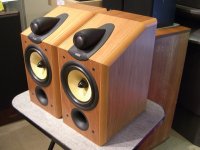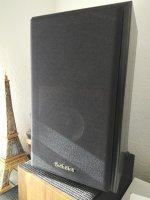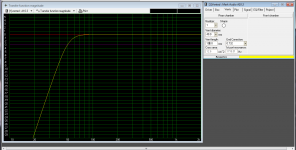That's because there aren't any. 😉 They aren't optimised per se, since by nature they're generic. They work perfectly well if you're not pitching for a very specific alignment, but have space restrictions preventing you from using the sealed box alignment you want, or simply want to lower the system Q, which is fair enough. You can get similar (and more adjustable, though probably less attractive) results by either drilling a bunch of holes in your enclosure & backing them with open-cell foam, fiberglass or whatever, cutting a slot in the box & stuffing it with the same, or sandwiching said damping between a couple of PC PSU fan guards & using that as a DIY equivalent.
By the way I think the boxes are made of a material called Corian.
I think it's about time you posted a pic of these boxes.
jeff
FWIW, I've currently got 2 interesting pairs of speakers at home right now - not for an intentional comparison, but sometimes those things just work out -serendipitously.
A10P in Steve Deckert's cute little DNA Horn, and A10.2 in approx 12 litre sealed. The horn has a much warmer, resonant bottom end, but above 200(?) I only hear the difference between the drivers' native signatures.
Octavia - do not try to screw directly into the Corian - attach front baffle to wide wooden cleats adhered with a wide wavey pattern of Sikabond or similar silicone one polyurethane construction adhesive cured overnight.
A10P in Steve Deckert's cute little DNA Horn, and A10.2 in approx 12 litre sealed. The horn has a much warmer, resonant bottom end, but above 200(?) I only hear the difference between the drivers' native signatures.
Octavia - do not try to screw directly into the Corian - attach front baffle to wide wooden cleats adhered with a wide wavey pattern of Sikabond or similar silicone one polyurethane construction adhesive cured overnight.
Hmm ok front baffle could look pretty sharp. I'm still waiting on the drivers, no rez and still need to figure what port to order. Once construction is underway I'll be sure and take pics to share. I think I will stick with the ported 42Hz alignment. Thanks again.
You guys probably know this stuff already - but I was still in the throws of trying to figure out should I have the port in front or back (having eliminated the bottom port idea based on your advice). So I have decided to go back to the dual flair precision port and have it mounted on back. This bit below from studio monitor manufacturer Genelec helped me decide;
How does a rear reflex port opening work? What are the benefits of such design?
The main benefit of a reflex port in an enclosure is that it enables the loudspeaker to produce low frequencies at a very low distortion level, close to the frequencies where the bass reflex has been tuned. This enables very linear low frequency reproduction systems to be designed.
The bass reflex port allows air to move in and out. The reflex is effective if the energy losses of this air movement remain small. Because of this reason the reflex port is designed so that the speed of the air moving in the reflex port remains fairly small while the port is in resonance.
The direction where the bass reflex port is facing does not greatly influence the work of the bass reflex. While it is in resonance the reflex port generates low frequency sound. This sound sums with the low frequency sound output from the woofer at other frequencies. The distance and location of the bass reflex port is designed so that this summation works correctly.
If the reflex port is not sufficiently large, the air motion in the port can become turbulent (non-linear). This will dramatically increase air flow losses in the reflex port. The higher flow losses can cause the bass reflex to stops working. This will change the low frequency characteristics of the loudspeaker. In Genelec designs we take care to dimension the reflex port to have sufficient capacity to support the system up to the maximum sound level output.
In several Genelec products the bass reflex port opening is behind the enclosure. When you push the loudspeaker close to a wall, a small gap to the wall is needed to enable the bass reflex to work at full capacity. Our experiences show that a distance of twice (2x) the port diameter from the wall to the enclosure back is a very safe distance.
Benefits of a reflex port opening in the rear of the cabinet:
It allows to have a maximized waveguide (DCW) area on the enclosure front
It minimizes acoustic diffraction as the front of the enclosure has no holes, vents or slots. This is especially significant near the tweeter.
The port opening, or flare, can be significantly larger, ensuring laminar flow up to high sound level outputs, high linearity and low system distortion at woofer frequencies.
It minimizes the audibility of air flow in the port because the port opening is faced away from the listener. When the air flow in the port generates noise, this noise is typically 10…20 times higher in frequency than the port tuning frequency. The flow noise is therefore rather directional, and by having the port opening in the back, this noise is well attenuated compared to having a port in the front and directing such noises towards the listener.
How does a rear reflex port opening work? What are the benefits of such design?
The main benefit of a reflex port in an enclosure is that it enables the loudspeaker to produce low frequencies at a very low distortion level, close to the frequencies where the bass reflex has been tuned. This enables very linear low frequency reproduction systems to be designed.
The bass reflex port allows air to move in and out. The reflex is effective if the energy losses of this air movement remain small. Because of this reason the reflex port is designed so that the speed of the air moving in the reflex port remains fairly small while the port is in resonance.
The direction where the bass reflex port is facing does not greatly influence the work of the bass reflex. While it is in resonance the reflex port generates low frequency sound. This sound sums with the low frequency sound output from the woofer at other frequencies. The distance and location of the bass reflex port is designed so that this summation works correctly.
If the reflex port is not sufficiently large, the air motion in the port can become turbulent (non-linear). This will dramatically increase air flow losses in the reflex port. The higher flow losses can cause the bass reflex to stops working. This will change the low frequency characteristics of the loudspeaker. In Genelec designs we take care to dimension the reflex port to have sufficient capacity to support the system up to the maximum sound level output.
In several Genelec products the bass reflex port opening is behind the enclosure. When you push the loudspeaker close to a wall, a small gap to the wall is needed to enable the bass reflex to work at full capacity. Our experiences show that a distance of twice (2x) the port diameter from the wall to the enclosure back is a very safe distance.
Benefits of a reflex port opening in the rear of the cabinet:
It allows to have a maximized waveguide (DCW) area on the enclosure front
It minimizes acoustic diffraction as the front of the enclosure has no holes, vents or slots. This is especially significant near the tweeter.
The port opening, or flare, can be significantly larger, ensuring laminar flow up to high sound level outputs, high linearity and low system distortion at woofer frequencies.
It minimizes the audibility of air flow in the port because the port opening is faced away from the listener. When the air flow in the port generates noise, this noise is typically 10…20 times higher in frequency than the port tuning frequency. The flow noise is therefore rather directional, and by having the port opening in the back, this noise is well attenuated compared to having a port in the front and directing such noises towards the listener.
Sorry if I was misunderstood. I didn't mean that front ports can't work. I was just saying their comments helped me decide on a rear port for my specific project. Fortunately I can have the speakers on a shelf that is around 28 inches deep and lets me play around with distance to the wall behind the speaker. Also it is just wall up to the ceiling so no upper shelves to be concerned with. If I had to have the speakers right up against the wall it would make much more sense to have the port in front. The other element was that the outer flare rim of the 2" Precision Port (that's the Brand name) is kinda big - 5.25" so it will just fit more easily on its own rear baffle.
Re Genelec's comments, notwithstanding some dodgy phrasing they're basically correct, although I certainly wouldn't accept the universal applicability of some of their statements. Re positioning & rear-facing ducts, spacing to the front wall twice the duct diameter may be fine for their designs, but in practice this will depend on both the room construction & enclosure alignment, so is an ROT only. Likewise the comments about rear vent positioning allowing a 'full-sized waveguide' of course only applies if the vent were limiting size in the first place. 😉
ChrisB Thanks for the recommendation on attaching a baffle. I'll get some help on that from a friend and probably make the whole thing look better too. No parts arrived so far but nice to have a holiday project to look forward to. Thanks for everyone's good help. I'll post pics as things progress.
Hi there,
Did not know where to ask, this thread seems to have something in common with the issue that I have.
I built a BR box for Alpair 10.3. (In fact, I used some "Technics" two-way boxes. )
The recommended port size is, if I got it correctly, 50mm diameter and 160mm length.
But, the existing box already had a port on front, albeit 40mm diameter. As it was initially too short, I added a pipe and made it around 160mm long.
Now I realized that I have mistuned the box. If the BR port diameter is smaller, the port would have to get shorter in order to keep the same tuning frequency.
But, the question is, how much shorter?
Maybe around 100mm lenth (or, more, or less, I have no clue). Any idea?
Thanks
Did not know where to ask, this thread seems to have something in common with the issue that I have.
I built a BR box for Alpair 10.3. (In fact, I used some "Technics" two-way boxes. )
The recommended port size is, if I got it correctly, 50mm diameter and 160mm length.
But, the existing box already had a port on front, albeit 40mm diameter. As it was initially too short, I added a pipe and made it around 160mm long.
Now I realized that I have mistuned the box. If the BR port diameter is smaller, the port would have to get shorter in order to keep the same tuning frequency.
But, the question is, how much shorter?
Maybe around 100mm lenth (or, more, or less, I have no clue). Any idea?
Thanks
In order to guesstimate a decent alignment, could you tell us the enclosure volume? If I just ignore volume, and plug your 40mm port in, I end up with a stab in the dark of 133mm length, for a QB3 alignment in a 10.7l enclosure.Hi there,
Did not know where to ask, this thread seems to have something in common with the issue that I have.
I built a BR box for Alpair 10.3. (In fact, I used some "Technics" two-way boxes. )
The recommended port size is, if I got it correctly, 50mm diameter and 160mm length.
But, the existing box already had a port on front, albeit 40mm diameter. As it was initially too short, I added a pipe and made it around 160mm long.
Now I realized that I have mistuned the box. If the BR port diameter is smaller, the port would have to get shorter in order to keep the same tuning frequency.
But, the question is, how much shorter?
Maybe around 100mm lenth (or, more, or less, I have no clue). Any idea?
Thanks
Unless you are going to really dig into this, my advice would be to figure a way to add 10mm sections of pipe, and just listen to it with as many lengths as you want to try. Taping the lengths would probably work just fine for testing purposes. Main thing is try to avoid any gaps where you'd lose some air pressure.
Hello,In order to guesstimate a decent alignment, could you tell us the enclosure volume? If I just ignore volume, and plug your 40mm port in, I end up with a stab in the dark of 133mm length, for a QB3 alignment in a 10.7l enclosure.
Unless you are going to really dig into this, my advice would be to figure a way to add 10mm sections of pipe, and just listen to it with as many lengths as you want to try. Taping the lengths would probably work just fine for testing purposes. Main thing is try to avoid any gaps where you'd lose some air pressure.
Enclosure volume is close to 15 L. A bit less if we account the volume taken by the driver. So, between 14 and 15 L, we could say...
Trying different lengths would be best, but it is a bit tedious.
I will try to cut it to 130mm and see what happens...
Hello,
Enclosure volume is close to 15 L. A bit less if we account the volume taken by the driver. So, between 14 and 15 L, we could say...
Trying different lengths would be best, but it is a bit tedious.
I will try to cut it to 130mm and see what happens...
Calling it 13.5L, allowing for driver and vent vol., here's a quick sim with a 100mm long vent. Series resistance is .5R. Looks ok.
jeff
Attachments
- Home
- Loudspeakers
- Full Range
- Alpair 10.3 bass reflex



